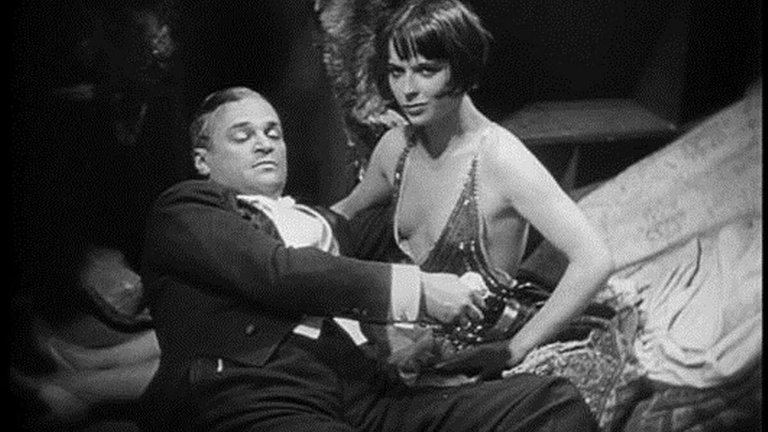Film Review: Pandora's Box (Die Büchse der Pandora, 1929)

Louise Brooks is one of the greatest and one of the last icons of silent cinema. Much of that was built on her colourful, ultra-hedonistic and scandalous private life which, just like her bob hairstyle, perfectly encapsulated the Jazz Age. Although she began her career in Hollywood, the film she is best remembered for was made elsewhere. It was Pandora’s Box, 1929 drama directed by Georg Wilhelm Pabst, known as one of the last silent classics of German cinema.
The plot is based on Earth’s Spirit (“Erdgeist”) and Pandora’s Box, two plays by German author Franz Wedekind. Brooks plays the main character, beautiful dancer named Lulu who is able to make almost any men and even some women fall in love, often with tragic and destructive results. Plot begins with Lulu as mistress of rich newspaper publisher Dr. Ludwig Schön (played by Fritz Kortner) who informs her that is about to marry Charlotte von Zarnikow (played by Daisy D’Ora), daughter of government minister. She nevertheless manages to manipulate Schön into marrying her instead, but her husband soon finds her in what appear to be compromising situations with two men – sinister-looking Schigolch (played by Carl Goetz) and young variety artist Rodrigo Quast (played by Krafft-Rashig). Dr. Schön’s jealousy leads to incident that would result in his shooting death. Lulu is tried and sentenced for manslaughter but she escapes country with the help of Dr. Schön’s son Alwa (played by Francis Lederer) and Countess Augusta Geschwitz (played by Alice Roberts) who are both infatuated with her. Times, however, become hard and Lulu is forced to make ends meet by selling herself on the streets of London, which would lead to fateful encounter with Jack the Ripper (played by Gustav Diessl).
Pandora’s Box was directed by Georg Wilhelm Pabst, Austrian film maker who was, at the time one of the most prominent representatives of New Objectivity, art movement in Germany that tried to replace Expressionism in cinema with more realistic approach towards the world. Pabst, who has started much of that trend with his 1925 classic The Joyless Street, also known for helping Swedish actress Greta Garbo reach international stardom. Pabst, like many of late silent era film makers, already had great visual tools at his disposal and his talent makes Pandora’s Box look quite modern – almost like it needs only few more sound and perhaps few shades of extra colour to look exactly like the film made today. Its episodic plot, chronicling the rise and fall of its (anti)heroine is handled extremely well, never succumbing to unnecessary melodrama.
The most valuable asset for Pabst was, however, his main actress. Brooks, who, despite starring in couple American films had burned too many bridges in Hollywood, considered starring in silent German production as better alternative to maintain her career. Pabst, who had originally wanted Marlene Dietrich to star as Lulu, was quite enthusiastic supporter of American actress, working extensively to develop her look as well as guide her, more naturalistic style of acting. Brooks, who oozes eroticism and, despite her vampish looks, functions more like a force of nature than traditional femme fatale, had delivered one of the greatest and the most iconic acting performances of the silent era. She is well-matched by the rest of cast, despite some of them not being particularly enthusiastic about her on the set, like Fritz Kortner, or Belgian actress Alice Roberts who was quite uncomfortable about her character being lesbian.
Pandora’s Box, however, wasn’t greeted well upon initial release. Critics considered it too exploitative and scandalous and the censorship in many countries – which didn’t look kindly at motives of prostitution and lesbianism as well as violent ending – resulted in serious and many competing versions. However, it was unstoppable arrival of sound that made the film quickly disappear from memory. Brooks’ career as as an actress ended very quickly and, like character of Lulu, was later forced by make a living as prostitute. It was only in 1950s when silent classics of Weimar Germany were rediscovered by critics and scholars and Brooks’ performance recognised as one of the finest of the era. Brooks’ Lulu later became object of many homages, which include character of Sally Bowles in Cabaret and Melanie Griffith as protagonist Jonathan Demme’s Something Wild.
RATING: 7/10 (+++)
Blog in Croatian https://draxblog.com
Blog in English https://draxreview.wordpress.com/
Leofinance blog https://leofinance.io/@drax.leo
Cent profile https://beta.cent.co/@drax
Minds profile https://www.minds.com/drax_rp_nc
Uptrennd profile https://www.uptrennd.com/user/MTYzNA
Unstoppable Domains: https://unstoppabledomains.com/?ref=3fc23fc42c1b417
Hiveonboard: https://hiveonboard.com?ref=drax
Bitcoin Lightning HIVE donations: https://v4v.app/v1/lnurlp/qrcode/drax
Rising Star game: https://www.risingstargame.com?referrer=drax
1Inch: https://1inch.exchange/#/r/0x83823d8CCB74F828148258BB4457642124b1328e
BTC donations: 1EWxiMiP6iiG9rger3NuUSd6HByaxQWafG
ETH donations: 0xB305F144323b99e6f8b1d66f5D7DE78B498C32A7

And here I thought I was the only one who liked to go old school on films. Thanks for prinvg me wrong.
Sadly I am not familiar with Louise Brooks of Pandora's Box, however this film sounds like it should be a very good film to watch, and adding it to my list of films that are a must see. Thanks for introducing me to it.
!PIZZA
Posted using CineTV
PIZZA Holders sent $PIZZA tips in this post's comments:
@thunderjack(1/5) tipped @drax (x1)
Learn more at https://hive.pizza.
https://twitter.com/21393347/status/1636331326428135425
The rewards earned on this comment will go directly to the people( @drax ) sharing the post on Twitter as long as they are registered with @poshtoken. Sign up at https://hiveposh.com.